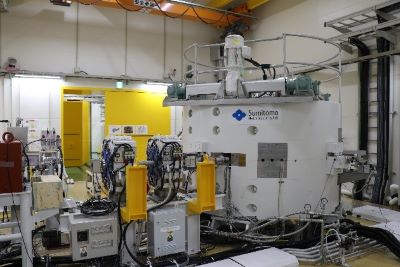SHI succeeds in developing a superconducting cyclotron for proton therapy -Toward widespread use of proton therapy
October 26, 2021
Sumitomo Heavy Industries, Ltd. (President: Shinji Shimomura, hereinafter referred to as "SHI") has conducted proton beam acceleration tests on its in-house developed superconducting cyclotron for the next-generation proton therapy system under development and confirmed the generation of a high-intensity proton beam of 1,000 nA. The successful development of the superconducting cyclotron is a significant step toward realizing the next-generation proton therapy system being developed by SHI.
In recent years, scanning irradiation has been used in proton therapy. In scanning irradiation, thin proton beams are scanned according to the tumor's shape, thereby minimizing damage to normal tissues and organs around the tumor. To accurately treat tumors in the lungs and livers, which move with respiration, using scanning irradiation, it is necessary to irradiate the tumor in a short time while suppressing the movement caused by respiration. Scanning the proton beam at high intensity and ultra-high speed is essential to achieve such a short irradiation time.
This time, SHI has succeeded in developing a superconducting cyclotron capable of generating a high-intensity proton beam of 1000 nA, the world's highest level for a proton therapy system. Conventionally, irradiating a tumor with a proton beam requires a long time. However, the newly developed superconducting cyclotron can increase the intensity of the proton beam more than three times and shorten the irradiation time to less than one-third. In addition, the use of superconducting magnets reduces the power consumption by 40%, making it possible to operate the proton therapy system at lower cost.

In the future, SHI will conduct beam tests in combination with the ultra high-speed scanning technology under development. The company will continue to accelerate product development in order to bring proton therapy, a less invasive cancer treatment, to as many patients as possible.
*Next-generation proton therapy system is under development and cannot be sold.
